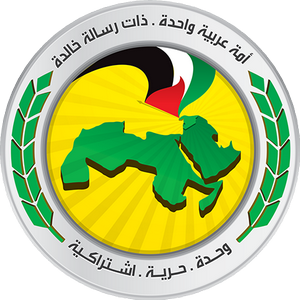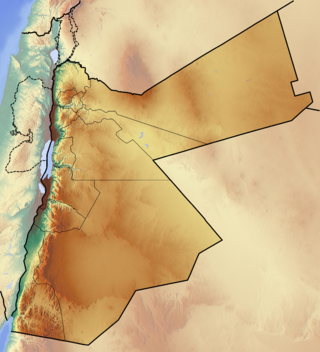Related Research Articles

The Levant is the subregion that borders the Eastern Mediterranean sea to the west and core West Asia, or by the political term, Middle East, to the east. In its narrowest sense, which is in use today in archaeology and other cultural contexts, it is equivalent to Cyprus and a stretch of land bordering the Mediterranean Sea in western Asia: i.e. the historical region of Syria, which includes present-day Israel, Jordan, Lebanon, Syria, the Palestinian territories and most of Turkey southwest of the middle Euphrates. Its overwhelming characteristic is that it represents the land bridge between Africa and Eurasia. In its widest historical sense, the Levant included all of the Eastern Mediterranean with its islands; that is, it included all of the countries along the Eastern Mediterranean shores, extending from Greece in Southern Europe to Egypt and Cyrenaica in Northern Africa.

The Arabian Peninsula, or Arabia, is a peninsula in West Asia, situated northeast of Africa on the Arabian Plate. At 3,237,500 km2 (1,250,000 sq mi), comparable in size to India, the Arabian Peninsula is the largest peninsula in the world.

Kurdistan, or Greater Kurdistan, is a roughly defined geo-cultural region in West Asia wherein the Kurds form a prominent majority population and the Kurdish culture, languages, and national identity have historically been based. Geographically, Kurdistan roughly encompasses the northwestern Zagros and the eastern Taurus mountain ranges.

West Asia is the westernmost region of Asia. As defined by most academics, UN bodies and other institutions, the subregion consists of Anatolia, the Arabian Peninsula, Iran, Mesopotamia, the Armenian highlands, the Levant, the island of Cyprus, the Sinai Peninsula and the South Caucasus. The region is separated from Africa by the Isthmus of Suez in Egypt, and separated from Europe by the waterways of the Turkish Straits and the watershed of the Greater Caucasus. Central Asia lies to its northeast, while South Asia lies to its east. Twelve seas surround the region (clockwise): the Aegean Sea, the Sea of Marmara, the Black Sea, the Caspian Sea, the Persian Gulf, the Gulf of Oman, the Arabian Sea, the Gulf of Aden, the Red Sea, the Gulf of Aqaba, the Gulf of Suez, and the Mediterranean Sea. West Asia contains the majority of the similarly defined Middle East. The Middle East is a political term that has changed many times depending on political and historical context while West Asia is a geographical term with more consistency. It excludes most of Egypt and the northwestern part of Turkey, and includes the southern part of the Caucasus.

Sir Halford John Mackinder was a British geographer, academic and politician, who is regarded as one of the founding fathers of both geopolitics and geostrategy. He was the first Principal of University Extension College, Reading from 1892 to 1903, and Director of the London School of Economics from 1903 to 1908. While continuing his academic career part-time, he was also the Conservative and Unionist Member of Parliament for Glasgow Camlachie from 1910 to 1922. From 1923, he was Professor of Geography at the London School of Economics.

Arabization or Arabicization is a sociological process of cultural change in which a non-Arab society becomes Arab, meaning it either directly adopts or becomes strongly influenced by the Arabic language, culture, literature, art, music, and ethnic identity as well as other socio-cultural factors. It is a specific form of cultural assimilation that often includes a language shift. The term applies not only to cultures, but also to individuals, as they acclimate to Arab culture and become "Arabized". Arabization took place after the Muslim conquest of the Middle East and North Africa, as well as during the more recent Arab nationalist policies toward non-Arab minorities in modern Arab states, such as Algeria, Iraq, Syria, Egypt, Bahrain, and Sudan.
Shams al-Din Abu Abd Allah Muhammad ibn Ahmad ibn Abi Bakr, commonly known by the nisbaal-Maqdisi or al-Muqaddasī, was a medieval Arab geographer, author of The Best Divisions in the Knowledge of the Regions and Description of Syria .

The Middle East and North Africa (MENA), also referred to as West Asia and North Africa (WANA) or South West Asia and North Africa (SWANA), is a geographic region which comprises the Middle East and North Africa together. However, it is widely considered to be a more defined and apolitical alternative to the concept of the Greater Middle East, which comprises the bulk of the Muslim world. The region has no standardized definition and groupings may vary, but the term typically includes countries like Algeria, Bahrain, Egypt, Jordan, Kuwait, Lebanon, Libya, Morocco, Oman, Qatar, Saudi Arabia, Syria, Tunisia, the UAE, and Yemen.

Several different denominations and sects of Islam are practised within Syria, who collectively constitute approximately 87% of the population and form a majority in most of the districts of the country.
Joseph Albert Kéchichian is a political scientist.
Dame Sarah Jane Whatmore is a British geographer. She is a professor of environment and public policy at Oxford University. She is a professorial fellow at Keble College, moving from Linacre College in 2012. She was associate head (research) of the Social Sciences Division of the university from 2014 to 2016, and became pro-vice chancellor (education) of Oxford in January 2017. From 2018 she has been head of the Social Sciences Division.

Hikmat al-Shihabi was a Syrian military officer who served as the chief of staff of the Syrian Army from 1974 to 1998. A Sunni Muslim, he was considered one of the few non-Alawite members of the inner circle of former Syrian President Hafez al-Assad.

The Corrective Movement, also referred to as the Corrective Revolution or the 1970 coup, was a bloodless military coup d'état led by General Hafez al-Assad on 13 November 1970 in Syria. Assad promised to sustain and improve the "nationalist socialist line" of the state and the Ba'ath Party. The Ba'ath party adopted an ideological revision, absolving itself of Salah Jadid's doctrine of exporting revolutions. The new doctrine placed emphasis on defeating Israel, by developing the Syrian military with the support of the Soviet Union.

The Arab Socialist Ba'ath Party – Syria Region, officially the Syrian Regional Branch, was a neo-Ba'athist organisation founded on 7 April 1947 by Michel Aflaq, Salah al-Din al-Bitar and followers of Zaki al-Arsuzi. The party ruled Syria from the 1963 Syrian coup d'état, which brought the Ba'athists to power, until 8 December 2024, when Bashar al-Assad fled Damascus in the face of a rebel offensive during the Syrian Civil War. The party suspended all activities on 11 December 2024 "until further notice" and transferred its assets to the Syrian transitional government, de facto dissolving the party.
Muhammad al-Sufi was a Syrian field marshal who played a role in the 1963 Syrian coup d'état and briefly served as Defense Minister between March and May of that year. Politically a Nasserist, he was sidelined by Ba'athist rivals in the military and departed the political scene before returning to Syria in the 1990s.
Gerald Henry Blake is a retired British academic and geographer. He is Professor Emeritus of Geography at Durham University. He was Principal of Collingwood College, Durham from 1987 to 2001.
Dawn Chatty, is an American Emerita Professor of Anthropology and Forced Migration, who specialises in the Middle East, nomadic pastoral tribes, and refugees. From 2010 to 2015, she was Professor of Anthropology and Forced Migration at the University of Oxford and from 2011 to 2014, Director of the Refugee Studies Centre.

The Jordan–Saudi Arabia border is 731 km (454 mi) in length and runs from the Gulf of Aqaba in the south-west to the tripoint with Iraq in the north-east.
Fabrice Balanche is a geographer and specialist in the political geography and the geopolitics of Syria, Lebanon, Iraq and the Middle East in general.
Ronald Bruce St. John, also known as R. Bruce St. John, is an American historian and writer on international relations, an affiliate professor of Bradley University.
References
- ↑ "New Associate Dean Named". University of New Hampshire. 13 August 2013. Archived from the original on 19 November 2015. Retrieved 10 November 2015.
- ↑ "Emeriti". University of New Hampshire. 2017. Archived from the original on 10 May 2017. Retrieved 8 December 2017.
- ↑ "A D Drysdale" (PDF). The Strathallian . Vol. 14, no. 5. 1988. p. 68. Archived from the original (PDF) on 17 November 2015. Retrieved 10 November 2015.
- 1 2 3 "Alasdair Drysdale". University of New Hampshire. 2015. Retrieved 10 November 2015.
- ↑ "The Middle East in the 1990s". United States Government Publishing Office. 1991. pp. 205–230. Retrieved 15 November 2015.
- ↑ "Editorial Advisory Board" (PDF). The Northeastern Geographer. 4 (2): 1. 2012. Retrieved 14 November 2015.
- ↑ "International Editorial Advisory Board". Arab World Geographer. 18 July 2011. Retrieved 11 November 2015.
- ↑ "International Advisory Board". Geopolitics. 5 (2): ebi. 2000. CiteSeerX 10.1.1.476.8765 . doi:10.1080/14650040008407674. S2CID 216590042.
- ↑ Alasdair Drysdale publications indexed by Microsoft Academic